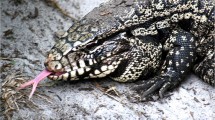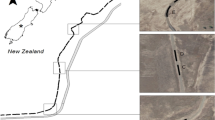Abstract
Finding practical ways to robustly estimate abundance or density trends in threatened species is a key facet for effective conservation management. Further identifying less expensive monitoring methods that provide adequate data for robust population density estimates can facilitate increased investment into other conservation initiatives needed for species recovery. Here we evaluated and compared inference-and cost-effectiveness criteria for three field monitoring-density estimation protocols to improve conservation activities for the threatened Komodo dragon (Varanus komodoensis). We undertook line-transect counts, cage trapping and camera monitoring surveys for Komodo dragons at 11 sites within protected areas in Eastern Indonesia to collect data to estimate density using distance sampling methods or the Royle–Nichols abundance induced heterogeneity model. Distance sampling estimates were considered poor due to large confidence intervals, a high coefficient of variation and that false absences were obtained in 45 % of sites where other monitoring methods detected lizards present. The Royle–Nichols model using presence/absence data obtained from cage trapping and camera monitoring produced highly correlated density estimates, obtained similar measures of precision and recorded no false absences in data collation. However because costs associated with camera monitoring were considerably less than cage trapping methods, albeit marginally more expensive than distance sampling, better inference from this method is advocated for ongoing population monitoring of Komodo dragons. Further the cost-savings achieved by adopting this field monitoring method could facilitate increased expenditure on alternative management strategies that could help address current declines in two Komodo dragon populations.


Similar content being viewed by others
References
Anson JR, Dickman CR, Boonstra R, Jessop TS (2013a) Stress triangle: do introduced predators exert indirect costs on native predators and prey? PLoS ONE 8:e60916. doi:10.1371/journal.pone.0060916
Anson JR, Dickman CR, Handasyde K, Jessop TS (2013b) Effects of multiple disturbance processes on arboreal vertebrates in eastern Australia: implications for management. Ecography 37:357–366
Ariefiandy A, Purwandana D, Aganto S, Ciofi C, Jessop TS (2013a) Can camera traps monitor Komodo dragons a large ectothermic predator? PLoS ONE 8(3):e58800. doi:10.1371/journal.pone.0058800
Ariefiandy A, Purwandana D, Coulson G, Forsyth D, Jessop TS (2013b) Monitoring the ungulate prey of the Komodo dragon Varanus komodoensis: distance sampling or faecal counts? Wildl Biol 19:1–12
Auffenberg W (1981) The Behavioural ecology of the Komodo monitor. University Presses of Florida, Gainesville
Buckland ST, Anderson DR, Burnham KP, Laake JL, Borchers DL, Thomas L (2001) Introduction to distance sampling. Oxford University Press, London
Bull JJ, Jessop TS, Whiteley M (2010) Deathly drool: evolutionary and ecological basis of septic bacteria in Komodo dragon mouths. PLoS ONE 5:e11097
Burnham KP, Anderson DR (2002) Model selection and multimodel inference: a practical information-theoretic approach, 2nd edn. Springer, New York
Ciofi C, De Boer M (2004) Distribution and conservation of the Komodo monitor (Varanus komodoensis). Herpetol J 14:99–107
Couturier T, Cheylan M, Bertolero A, Astruc G, Besnard A (2013) Estimating abundance and population trends when detection is low and highly variable: a comparison of three methods for the Hermann’s tortoise. J Wildl Manag 77(3):454–462
Doody JS, Green B, Rhind D, Castellano CM, Sims R, Robinson T (2009) Population-level declines in Australian predators caused by an invasive species. Anim Conserv 12:46–53
Griffiths AD, McKay JL (2007) Cane toads reduce the abundance and site occupancy of freshwater goannas Varanus mertensi. Wildl Res 34:609–615
Harlow HJ, Purwandana D, JessopTS Phillips JA (2010) Body temperature and thermoregulation of Komodo dragons in the field. J Therm Biol 35:338–347
Hines JE (2006) PRESENCE 5.5—Software to estimate patch occupancy and related parameters. USGS-PWRC. http://www.mbr-pwrc.usgs.gov/software/ presence.html
Imansyah MJ, Jessop TS, Ciofi C, Akbar Z (2008) Ontogenetic differences in the spatial ecology of immature Komodo dragons. J Zool 274:107–115
Inskip C, Zimmermann A (2009) Human-felid conflict: a review of patterns and priorities worldwide. Oryx 43:18–34
International Union for Conservation of Nature [IUCN] (2001) IUCN red list categories and criteria. Version 3.1. IUCN, Cambridge
Jenkins M, Broad S (1994) International trade in reptile skins: a review and analysis of the main consumer markets 1983–91′. TRAFFIC International, Cambridge
Jessop TS, Sumner J, Rudiharto H, Purwandana D, Imansyah MJ, Phillips JA (2004) Distribution, use and selection of nest type by Komodo dragons. Biol Conserv 117:463–470
Jessop TS, Madsen T, Sumner J, Rudiharto H, Phillips JA, Ciofi C (2006) Maximum body size among insular Komodo dragon populations covaries with large prey density. Oikos 112:422–429
Jessop TS, Madsen T, Ciofi C, Imansyah MJ, Purwandana D, Rudiharto H, Ariefiandy A, Phillips JA (2007) Island differences in population size structure and catch per unit effort and their conservation implications for Komodo dragons. Biol Conserv 135:247–255
Jessop T, Smissen P, Scheelings F, Dempster T (2012) Meal ticket or last supper: effects of a human mediated tropic subsidy on a large Australian predator. PLoS ONE 4:e34069. doi:10.1371/journal.pone.0034069
Jessop TS, Kearney MR, Moore JL, Lockwood T, Johnston M (2013) Evaluating and predicting risk to a large reptile from feral cat baiting protocols. Biol Invasions. doi:10.1007/s10530-012-0398-348
Karanth KU, Gopalaswamy AM, Kumar NS, Vaidyanathan S, Nichols JD, MacKenzie DI (2011) Monitoring carnivore populations at the landscape scale: occupancy modelling of tigers from sign surveys. J Appl Ecol 48:1048–1056
Ke´ry M, Royle JA, Schmid H 2005 Modeling avian abundance from replicated counts using binomial mixture models. Ecological Applications 15:1450–1461
Khatiwada JR, Ghimire BP (2009) Conservation status of Varanus flavescens in Chitwan Nepal. Biawak 3:100–105
Laver RJ, Purwandana D, Ariefiandy A, Imansyah J, Forsyth D, Ciofi C, Jessop T (2012) Life-history and spatial determinants of somatic growth dynamics in Komodo dragon populations. PLoS ONE 7(9):e45398
Luxmoore R, Groombridge B (1990) Asian monitor lizards. A review of distribution, status, exploitation and trade in four selected species. Report to the CITES Secretariat, World Conservation Monitoring Centre, Cambridge
Mackenzie DI, Royle JA (2005) Designing occupancy studies: general advice and allocating survey effort. J Appl Ecol 42:1105–1114
MacKenzie DI, Nichols JD, Lachman GB, Droege S, Royle JA, Langtimm CA (2002) Estimating site occupancy rates when detection probabilities are less than one. Ecology 83:2248–2255
MacKenzie DI, Nichols JD, Royle JA, Pollock K, Bailey L, Hines JE (2006) Occupancy estimation and modelling—inferring patterns and dynamics of species occurrence. Elsevier Publishing, London
Marques TA, Thomas L, Fancy SG, Buckland ST (2007) Improving estimates of bird density using multiple-covariates distance sampling. Auk 124:1229–1243
McDonald-Madden E, Baxter PW, Fuller RA, Martin TG, Game ET, Montambault J, Possingham HP (2010) Monitoring does not always count. Trends Ecol Evol 25:547–550
Monk KA, Fretes YD, Liley GR (1997) The Ecology of Nusa Tenggara and Maluku. Oxford University Press, Oxford
Pannell DJ, Roberts AM, Park G, Alexander J (2013) Designing a practical and rigorous framework for comprehensive evaluation and prioritisation of environmental projects. Wildl Res 40(2):126–133
Pernetta AP (2009) Monitoring the trade: using the CITES database to examine the global trade in live monitor lizards (Varanus spp.). Biawak 3:37–45
Pollock KH, Nichols JD, Simons TR, Farnsworth GL, Bailey LL, Sauer JR (2002) Large scale wildlife monitoring studies: statistical methods for design and analysis. Environmetrics 13:105–119
Possingham HP, Wintle BA, Fuller RA, Joseph LN (2012) The conservation return on investment from ecological monitoring. In: Lindenmayer D, Gibbons P (eds) Biodiversity monitoring in Australia. CSIRO Publishing, Collingwood, pp 49–58
Purwandana D, Ariefiandy A, Imansyah MJ, Rudiharto H, Seno A, Ciofi C, Fordham D, Jessop TS (2014) Demographic status of Komodo dragon populations in Komodo National Park. Biol Conserv 171:29–35
Ray JC, Redford KH, Steneck RS, Berger J (2005) Large carnivores and the conservation of biodiversity. Island press, Washington, DC
Royle JA (2004) N-mixture models for estimating population size from spatially replicated counts. Biometrics 60:108–115
Royle JA, Nichols JD (2003) Estimating abundance from repeated presence-absence data or point counts. Ecology 84:777–790
Shine R, Ambariyanto M, Harlow P (1998) Ecological traits of commercially harvested water monitors, Varanus salvator, in northern Sumatra. Wildl Res 25:437–447
Thomas L, Laake JL, Rexstad EA, Strindberg S, Marques FFC, Buckland ST, Borchers DL, Anderson DR, Burnham KP, Burt ML, Hedley SL, Pollard JH, Bishop JRB, Marques TA (2009) DISTANCE 6.0. Release 2. Research Unit for Wildlife Population Assessment. University of St. Andrews, Fife, http://www.ruwpa.st-and.ac.uk/distance/ Last Accessed on 9 October 2012
Thomas L, Buckland ST, Rexstad EA, Laake JL, Strindberg S, Hedley SL, Bishop JRB, Marques TA, Burnham KP (2010) Distance software: design and analysis of distance sampling surveys for estimating population size. J Appl Ecol 47:5–14
Williams BK, Nichols JD, Conroy MJ (2002) Analysis and management of animal populations. Academic Press, San Diego
Wingard GJ, Harris RB, Amgalanbaatar S, Reading RP (2011) Estimating abundance of mountain ungulates incorporating imperfect detection: argali Ovis ammon in the Gobi Desert, Mongolia. Wildl Biol 17:93–101
Yoccoz NG, Nichols JD, Boulinier T (2001) Monitoring of biological diversity in space and time. Trends Ecol Evol 16:446–453
Acknowledgments
This Research was authorized under a collaborative research memorandum of understanding (MOU) between Indonesian Department of Forest Protection and Nature Conservation (PHKA) and the Komodo Survival Program. Animal experimental ethics committee approval was obtained from the University of Melbourne (under Permit 0911162.1). We thank the many Komodo National Park staff, Balai Besar Konservasi Sumber Daya Alam NTT staff, Komodo Islanders and Flores Islanders for facilitating, and assisting with our field research. Funding was provided through members of the American Zoological Association and European Association of Zoos and Aquaria contributing to the Komodo Species Survival Plan and Taronga Conservation Society Australia.
Author information
Authors and Affiliations
Corresponding author
Additional information
Communicated by Indraneil Das.
Appendix
Appendix
See Fig. 2 and Tables 3, 4, 5, 6
Rights and permissions
About this article
Cite this article
Ariefiandy, A., Purwandana, D., Seno, A. et al. Evaluation of three field monitoring-density estimation protocols and their relevance to Komodo dragon conservation. Biodivers Conserv 23, 2473–2490 (2014). https://doi.org/10.1007/s10531-014-0733-3
Received:
Revised:
Accepted:
Published:
Issue Date:
DOI: https://doi.org/10.1007/s10531-014-0733-3




